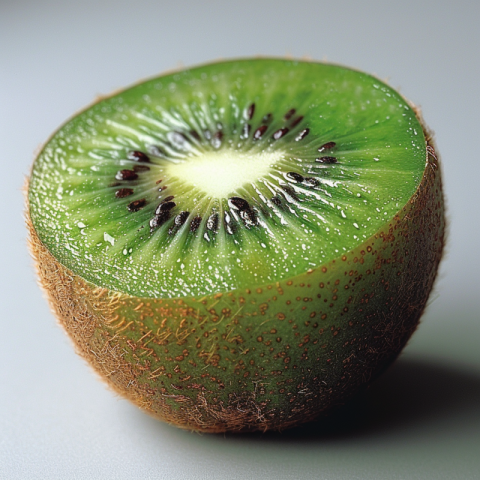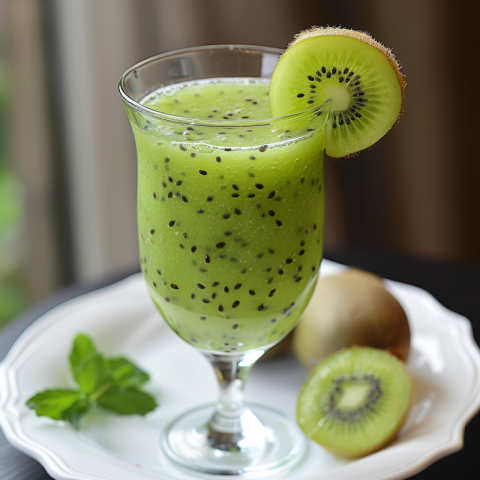








Kiwi: The Fuzzy Brown Fruit with a Tropical Twist - A Nutritional Powerhouse
The kiwifruit, often shortened to kiwi, is a small, fuzzy, brown fruit with vibrant green or golden flesh, speckled with tiny black seeds. Despite its unassuming exterior, the kiwi packs a powerful punch of flavor and nutrition. Its unique sweet-tart taste and refreshing texture have made it a popular addition to fruit salads, smoothies, desserts, and more.
1. A New Name for a Chinese Native: The History of the Kiwifruit
The kiwifruit's journey to global recognition is a story of rebranding and successful marketing:
- The kiwifruit is native to China, where it was known as yang tao.
- It was introduced to New Zealand in the early 20th century, where it was initially called the "Chinese gooseberry."
- In the 1950s, New Zealand growers began marketing the fruit as "kiwifruit," after the country's national bird, the kiwi, which is also small, brown, and fuzzy.
- The name change, along with effective marketing, helped to popularize the kiwifruit internationally.
2. Kiwifruit Varieties: Green and Gold
While there are many varieties of kiwifruit, the two most common are:
- Green Kiwifruit (Actinidia deliciosa 'Hayward'): The most widely recognized variety, with fuzzy brown skin and bright green flesh. It has a sweet and tangy flavor with hints of strawberry and melon.
- Gold Kiwifruit (Actinidia chinensis 'Hort16A'): A newer variety with smooth, bronze-colored skin and golden-yellow flesh. It has a sweeter, more tropical flavor with less tartness than the green variety.
- Other varieties: There are other less-common varieties including kiwiberry or hardy kiwi, which is smaller and can be eaten whole.
3. Nutritional Powerhouse: The Health Benefits of Kiwifruit
Kiwifruit is a nutritional powerhouse, packed with vitamins, minerals, and antioxidants:
- Vitamin C: Kiwifruit is an exceptional source of vitamin C, with a single fruit providing more than the recommended daily intake. Vitamin C is a powerful antioxidant that supports immune function and collagen production.
- Fiber: Kiwifruit is a good source of dietary fiber, which aids digestion, promotes satiety, and helps regulate blood sugar levels.
- Vitamin K: Important for blood clotting and bone health.
- Vitamin E: An antioxidant that helps protect cells from damage.
- Folate: A B vitamin that is essential for cell growth and development.
- Potassium: An electrolyte that helps regulate blood pressure and muscle function.
- Antioxidants: Kiwifruit contains various antioxidants, including flavonoids and carotenoids, which may help protect against chronic diseases.
4. Culinary Uses: From Breakfast to Dessert
Kiwifruit is a versatile fruit that can be enjoyed in many ways:
- Fresh Eating: Simply slice it in half and scoop out the flesh with a spoon, or peel and slice it.
- Fruit Salads: Adds a vibrant color and tangy flavor to fruit salads.
- Smoothies: Blends well with other fruits and yogurt for a nutritious and refreshing smoothie.
- Desserts: Can be used in tarts, pavlovas, and other desserts.
- Yogurt and Oatmeal: A delicious topping for yogurt or oatmeal.
- Salsa: Adds a unique flavor to salsa.
- Sauces: Can be incorporated into sauces for meat or fish.
5. Growing Kiwifruit: A Vine-Ripened Delight
Kiwifruit is grown on vines that require a temperate climate:
- Major kiwifruit-producing countries include China, Italy, New Zealand, Chile, and Greece.
- Kiwifruit vines are typically trained on trellises or pergolas.
- They require well-drained soil and regular watering.
- Kiwifruit is harvested in the fall.
6. The Kiwifruit's Impact on New Zealand: A National Symbol
The kiwifruit has become an important part of New Zealand's economy and national identity:
- New Zealand is one of the world's leading producers and exporters of kiwifruit.
- The kiwifruit industry provides jobs and economic benefits to the country.
- The kiwifruit is often featured in New Zealand tourism and marketing campaigns.
7. Potential Allergens
- Some individuals may have an allergy to kiwifruit.
- It is also high in oxalates, so those prone to kidney stones may need to limit their intake.
8. The Future of the Kiwifruit
- Researchers are developing new kiwifruit varieties with improved flavor, nutritional content, and disease resistance.
- The demand for kiwifruit is expected to continue to grow as consumers seek out healthy and flavorful fruits.
Conclusion:
The kiwifruit, with its fuzzy brown exterior and vibrant green or gold interior, is a unique and delicious fruit that has captured the attention of people worldwide. Its journey from the hills of China to global recognition is a testament to its appealing flavor and impressive nutritional profile. Whether enjoyed fresh, blended into a smoothie, or used as an ingredient in a variety of dishes, the kiwifruit offers a refreshing and healthy way to add a burst of flavor and nutrients to our diets. As research continues to uncover the full extent of its health benefits and new varieties are developed, the kiwifruit's popularity is sure to continue to grow.
Kiwifruit, kiwi, kiwifruit benefits, kiwifruit nutrition, kiwifruit varieties, green kiwifruit, gold kiwifruit, kiwiberry, hardy kiwi, kiwifruit history, where do kiwifruits grow, how to eat kiwifruit, kiwifruit recipes, kiwifruit smoothie, kiwifruit salad, kiwifruit dessert, kiwifruit allergy, kiwifruit plant, growing kiwifruit, kiwifruit vine, kiwifruit farming, kiwifruit season, kiwifruit from New Zealand, kiwifruit from China, health benefits of kiwifruit, kiwifruit vitamin C, kiwifruit seeds, buy kiwifruit online, kiwifruit price.

